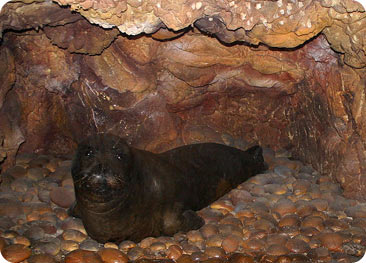Before the days of the Roman Empire, monk seals were just about as plentiful on Mediterranean beaches as tourists are today. Because of the seals’ love of sun and sea, the Greeks placed them under the protection of the gods Apollo and Poseidon.
 Diorama with a Mediterranean Monk seal at the Natural history museum in Milan, Italy. Credit: Giovanni Dall'Orto
Diorama with a Mediterranean Monk seal at the Natural history museum in Milan, Italy. Credit: Giovanni Dall'OrtoToday, the Mediterranean monk seal could use a little of that divine protection. It’s one of the most endangered mammals in the world.
The seals first fell prey to the Romans, who used their furs to make shoes, tents, and other products, and their fat to make candles.
The surviving seals left the beaches and moved into caves and grottoes, usually along the craggy coasts of remote islands. That allowed their populations to rebuild a bit.
In the 20th century, though, they faced new threats. Fishermen killed them because they damaged nets and competed for fish. And their habitat was destroyed by development and pollution. They disappeared from the Atlantic and the Black Sea, and their presence in the Mediterranean dwindled to alarming levels.
Today, only two major colonies remain. One is in the islands off the coasts of Greece and Turkey. Greece, in fact, has established a marine sanctuary to protect them. The other colony is along the northwestern coast of Africa. But about two-thirds of that colony was wiped out in 1997, although scientists aren’t sure why.
The few hundred remaining Mediterranean monk seals are listed as critically endangered. But scientists aren’t sure whether that designation will be enough to keep the seals from disappearing.

